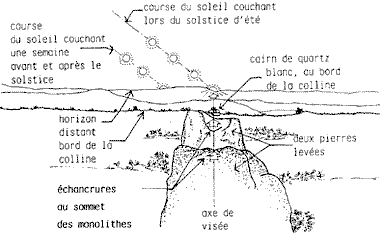By Brian Robinson
University of Maine
The so-called "Red Paint People" of nearby Maine provided one of New England's earliest archeological controversies. Evidence of the Red Paint People was found throughout the nineteenth century as groups of stone artifacts (for example, gouges or woodworking tools, fishing plummets, flaked stone knives and spearheads of ground slate) in deposits of bright red ocher (iron oxide powder). The first detailed excavations were conducted by Charles Willougby in 1892, for the Peabody Museum of Harvard University and his 1899 account remains a model of archeological reporting. Later work by Warren K. Moorehead (n.s. Peabody Museum, Andover, MA) from about 1912-1920 brought wider attention to the "Red Paint People" as well as controversy surrounding their identity.
Early Controversy
The controversy surrounding the age and identity of the people originated with the character of red ocher deposits. Although they were generally considered to be graves, they were apparently so old that no bones were preserved and some of the stone artifacts were even badly decayed. This led Moorehead to declare in the pages of the preimmenent journal, American Anthropology:
"It is our conviction that the graves represent an ancient and exceedingly primitive culture, totally diffferent from that of the later Algonquin tribes" (Moorehead 1913).
The proposal of a "new" ancient culture could not go unchallenged and the challenge came in 1914 from none other than David T. Bushnell of the Smithsonian Institution, who suggested that the Red Paint People may indeed be quite recent. This controversy occured long before the radiocarbon dating (carbon 14) techniques had been invented, and with so many controversies, that of the Red Paint People faded away with new information. Moorehead was correct that the graves were quite ancient, usually dating between 2,000 to 6,000 years ago, but with rocks going as far back as 6,000 years. Bushnell's concern was not unfounded, however, as the Smithsonian was at the time waging a battle against other "Satanic" interpretations of Native American archeology, most notably the theory that the Mound Builders of Midwestern United States were an ancient race of people, perhaps one of the seven tribes of Isreal, that came before the Indian cultures of North America.
Modern Theory
Archeology has come a long way since the turn of the century and presumably has a long way to go, if reserach can keep pace with all the agents of destruction, both natural and man made. The "Red Paint People" were initially only recognized from their cemetery sites and these are now more commonly referred to as the "Moorehead burial tradition" in archeological journal. Recent research, conducted by the Maine State Museum and various campuses of the University of Maine has foucused on the occupation sites or living areas of the people and their maritime hunting and fishing culture. The regular hunting of swordfish in the Gulf of Maine provides an example of their hunting and boating skills.
Ironically, some of the old "Mysteries of the Red Paint People" persist but for different reasons. One of the early theories explaining their disappearance called upon the then recent (1930) evidence that the coast of Maine was subsiding below the ocean. This geological evidence was expanded upon with the suggestion that the ocean side habitation areas of the people may have succumbed to tidal waves that resulted from violent earthquakes that caused the land to sink. While such catastrophes did not likely wipe the people out, the slow rise of the sea level is methodically destroying the coastal occupation sites and thus our ability to learn about them. Relatively few such sites remain after 4,000-5,000 years, and the few that have been excavated, such as the Turner Farm site in Penobscot Bay (Bruce Bourque 1995), contain precious glimpses of what was once a typical lifestyle of the area.
Photo courtesy NH Div of Historical Resources.
©1997 SeacoastNH.com. All rights reserved.
